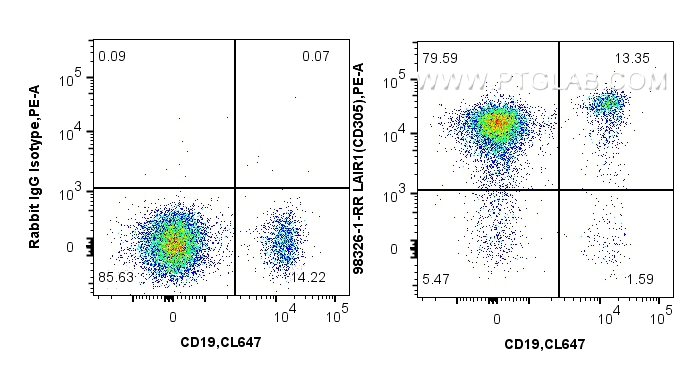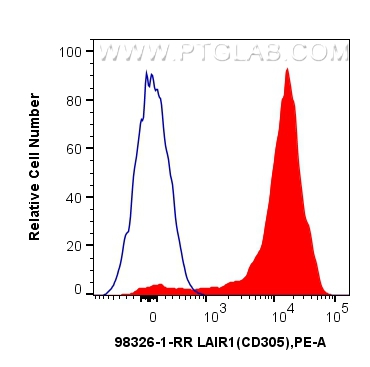验证数据展示
经过测试的应用
| Positive FC detected in | human PBMCs |
推荐稀释比
| 应用 | 推荐稀释比 |
|---|---|
| Flow Cytometry (FC) | FC : 0.13 ug per 10^6 cells in 100 μl suspension |
| This reagent has been tested for flow cytometric analysis. It is recommended that this reagent should be titrated in each testing system to obtain optimal results. | |
| Sample-dependent, Check data in validation data gallery. | |
产品信息
98326-1-RR targets LAIR1 in FC applications and shows reactivity with human samples.
| 经测试应用 | FC Application Description |
| 经测试反应性 | human |
| 免疫原 |
fusion protein 种属同源性预测 |
| 宿主/亚型 | Rabbit / IgG |
| 抗体类别 | Recombinant |
| 产品类型 | Antibody |
| 全称 | leukocyte-associated immunoglobulin-like receptor 1 |
| 别名 | Leukocyte-associated immunoglobulin-like receptor 1, LAIR-1, LAIR 1, hLAIR1, CD305 |
| 计算分子量 | 287 aa, 31 kDa |
| GenBank蛋白编号 | BC027899 |
| 基因名称 | LAIR1 |
| Gene ID (NCBI) | 3903 |
| 偶联类型 | Unconjugated |
| 形式 | Liquid |
| 纯化方式 | Protein A purification |
| UNIPROT ID | Q6GTX8 |
| 储存缓冲液 | PBS with 0.09% sodium azide, pH 7.3. |
| 储存条件 | Store at 2 - 8°C. Stable for one year after shipment. |
背景介绍
Leukocyte-associated immunoglobulin-like receptor 1 (LAIR1) is a transmembrane glycoprotein with a single immunoglobulin-like domain and a cytoplasmic tail containing two immune receptor tyrosine-based inhibitory motifs (PMID: 9285412). LAIR1 is expressed on the majority of human PBMCs, including NK, T, B, monocytes, and dendritic cells, as well as the majority of thymocytes (PMID: 10229813). It functions as an inhibitory receptor that plays a constitutive negative regulatory role on cytolytic function of NK cells, B cells and T cells. LAIR1 is a collagen receptor (PMID: 16754721). Tumor-expressed collagens can modulate immune cell function through the inhibitory collagen receptor LAIR1 (PMID: 21955987).
实验方案
| Product Specific Protocols | |
|---|---|
| FC protocol for LAIR1 antibody 98326-1-RR | Download protocol |
| Standard Protocols | |
|---|---|
| Click here to view our Standard Protocols |

